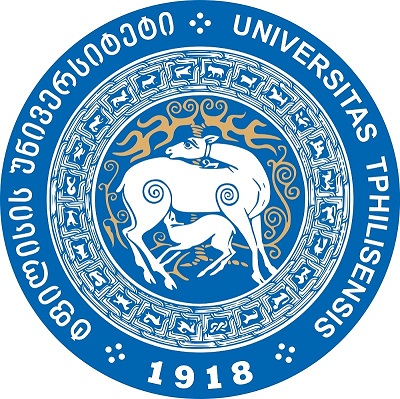 The artist Dimitri Shevardnadze, creatorof the Coat of Arms of Tbilisi State University, was one of the most prominent figures of Georgian culture in the 1920s and 30s. He was born on December 1, 1885 in the village of Bakhvi, in the Ozurgeti district and received his secondary education in Kutaisi, then left for St. Petersburg to study art. He continued his studies at the Academy of Fine Arts in Munich, with material support from the Georgian Literacy Society.
The artist Dimitri Shevardnadze, creatorof the Coat of Arms of Tbilisi State University, was one of the most prominent figures of Georgian culture in the 1920s and 30s. He was born on December 1, 1885 in the village of Bakhvi, in the Ozurgeti district and received his secondary education in Kutaisi, then left for St. Petersburg to study art. He continued his studies at the Academy of Fine Arts in Munich, with material support from the Georgian Literacy Society.
When Dimitri Shevardnadze returned to Georgia, he laid the foundation for the Georgian Artists' Society, and in 1917initiated an exhibition of murals in the "Temple of Glory".This building was subsequently handed over to the Georgian Artists' Society. In 1920 the first museum of fine arts in Georgia, the Georgian National Art Gallery,opened with Shevardnadze at its head. Dimitri Shevardnadzeperished in 1937, as a victim of the Soviet repressions.
TSU’s coat of arms is a round shield depicting a doe suckling a fawn (according to the Russian historian of heraldry, Alexander Lakier, it is Byzantine or Oriental), and while it is the most common form in glyptic, it is rarelyused in heraldry.The magnificent monuments of the Late Antique period – bronze openwork buckles - represent the last stage of Georgian artistic metal-work of the pre-Christian period and crown the brilliant traditions of this field. The figures depicted on the buckles are the ancient zoomorphic face of the fertility goddess, and the main figures of the University Coat of Arms – a doe and her fawn–emerged from that period of Georgian tradition.
On the Coat of Arms, the deer are surrounded bybronze buckles. The idea behind the art-work has been clearly and visually expressed--the act of transferring knowledge and wisdom from the elder generation to the younger is given a simple, poetic and, at the same time,symbolic image of the unity of generations.The doe hascircular designs on herflank and foreleg, and behind her, thesilhouette of theTree of Life expands over the background with stylized grape vines at itsbase which reach up to the Tree of Life to the right and left, above the doe.
The roundframe around the deer, created from 25 spiral ornaments of the shield, is surrounded by a frame consisting of 24 animal figures within an angular, braided ornament,contrasting with the curves of the figures and the shapes of the ornaments, to create a dynamic overall effect.The figures portray natural or mythical animals and birds in this order: a leopard, a lion, the horse Pegasus, a griffon, a dragon, Pegasus, a lion, a peacock, Pegasus, a lion, a sheep, an entwined snake, an antelope, a tiger, Pegasus, a lion, a griffon, a rhinoceros, a crowned snake, an owl, a roe deer, a lion, an antelope, and a lion.
Each figure isenclosed in an angular-linked frame, encircling the central images of the shield. The images were created in the style of the architectural decorations of the small Church of Ishkhani.).
Dimitri Shevardnadze took part in the third archeological expedition to southern Georgia in 1917, and along with other architectural monuments,he studied a church in Ishkhani(today located in Turkey)described by EkvtimeTakaishvili, as an "elegant church of rare beauty with extraordinarily delicate, beautiful decorations" built in 1006 by King Gurgen (994-1008), who was the first of theGeorgian Bagrationis to hold the title of ‘King of Kings’.
The striking stone-work on theentry facade of the Church of the Virgin Marywasbuilt with stones of different colors. Above the entry-way, the arched inscription carved in ancient Astomreuli text is a prominent example of Georgian sculptural ornamentation.Shevardnadze’s use of it for the Tbilisi University Coat of Arms can be explained from both artistic and symbolic perspectives.
For aesthetic effect, Dimitri Shevardnadze increased the number of figures of the decoration of the small church of Ishkhani to twenty-four, whilemaintainingstylistic integrity.Separated and united at the same time by the braided frames of the Coat of Arms, the outer partrepresents the World, within which the necessary condition for acquiring knowledge is like motherhood (symbolized by the doe) which forms a perfect union between mother and her young. This conveys the image of asolid union,such as a university that unites teachers and students, permitting the transmission of experience and wisdom from the older to the younger generation.
The image was added to the Seal of Tbilisi State University after approval of a draft sketch on February 5, 1918 at the Fourth Meeting of the Board of Professors of the newly established Tbilisi University. The Coat of Arms was subsequently depicted on university publications, and beginning with1922, badges with the image of the Coat of Arms were worn by university graduates. Today it still figures on the official documents and diplomas of Tbilisi State University.

 FACULTY OF EXACT AND NATURAL SCIENCES
FACULTY OF EXACT AND NATURAL SCIENCES
 FACULTY OF HUMANITIES
FACULTY OF HUMANITIES
 FACULTY OF SOCIAL AND POLITICAL SCIENCES
FACULTY OF SOCIAL AND POLITICAL SCIENCES
 FACULTY OF PSYCHOLOGY AND EDUCATIONAL SCIENCES
FACULTY OF PSYCHOLOGY AND EDUCATIONAL SCIENCES
 FACULTY OF ECONOMICS AND BUSINESS
FACULTY OF ECONOMICS AND BUSINESS
 FACULTY OF MEDICINE
FACULTY OF MEDICINE
 FACULTY OF LAW
FACULTY OF LAW



